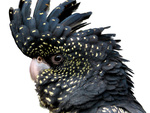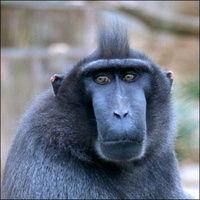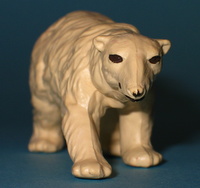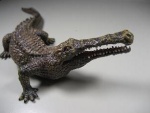| | Mathison Museum of Natural History |  |
|
+17Birdsage Bonnie Saarlooswolfhound widukind Joliezac spacelab Pardofelis landrover Megaptera lucky luke rogerpgvg Jill George pipsxlch Duck-Anch-Amun Kikimalou Roger 21 posters |
|
| Author | Message |
|---|
widukind

Country/State : Germany
Age : 48
Joined : 2010-12-30
Posts : 45745
 |  Subject: Re: Mathison Museum of Natural History Subject: Re: Mathison Museum of Natural History  Thu Dec 16, 2021 6:21 pm Thu Dec 16, 2021 6:21 pm | |
| |
|
  | |
Caracal

Country/State : France
Age : 65
Joined : 2018-10-24
Posts : 7252
 | |
  | |
bmathison1972

Country/State : Salt Lake City, UT
Age : 52
Joined : 2010-04-13
Posts : 6710
 |  Subject: Re: Mathison Museum of Natural History Subject: Re: Mathison Museum of Natural History  Fri Dec 17, 2021 12:42 pm Fri Dec 17, 2021 12:42 pm | |
| Species: Bombina orientalis Boulenger, 1890 (Oriental fire-bellied toad) About the Figure: Manufacturer: Yujin Series: Primary Colour Frogs Pictorial Book Year of Production: 2002 Size/Scale: Body length 4.0 cm, within scale 1:1 Frequency of species in toy/figure form (at time of posting): Very rare (possibly unique as a sculpt, see below) Miscellaneous Notes: Yujin released more than one collection of anurans. Several of the figures from the Primary Colour Frogs Pictorial Book, including today's, were produced by Play Visions and bear the PV logo, although they are stamped with the year 2002 (the original PV figures came out in 1996). I cannot tell from pics online if Play Visions just reused their 1996 sculpt for this figure or if they altered it slightly; the posture seems to be slightly different. About the Animal: Geographic distribution: East Asia, including northeast China, Korean Peninsula, southern Japan (Tsushima, Kiushiu Islands), eastern Russia (Khabarovsk, Primorye regions) Habitat: Wet and riparian areas in pine, spruce, and mixed forests, meadows, swampy brushland; water sources include lakes, ponds, swamps, streams, springs, puddles, ditches Diet: Tadpoles feed on algae, fungi, detritus, plants, and protozoans; adults eat terrestrial invertebrates IUCN Status (at time of posting): Least Concern Miscellaneous Notes: When confronted by a would-be predator, B. orientalis has a couple defense mechanisms. First, is to exhibit unkenreflex, whereby the toad flips on its back exposing the agressor to its bright red underside indicating that it is toxic to eat. In addition, the toad can exude a toxic milky-like substance through its skin. [You must be registered and logged in to see this image.] |
|
  | |
Caracal

Country/State : France
Age : 65
Joined : 2018-10-24
Posts : 7252
 | |
  | |
widukind

Country/State : Germany
Age : 48
Joined : 2010-12-30
Posts : 45745
 |  Subject: Re: Mathison Museum of Natural History Subject: Re: Mathison Museum of Natural History  Fri Dec 17, 2021 8:43 pm Fri Dec 17, 2021 8:43 pm | |
| |
|
  | |
lucky luke

Country/State : FRANCE Saint-Louis
Age : 62
Joined : 2010-07-17
Posts : 6296
 |  Subject: Re: Mathison Museum of Natural History Subject: Re: Mathison Museum of Natural History  Sat Dec 18, 2021 9:57 am Sat Dec 18, 2021 9:57 am | |
| |
|
  | |
bmathison1972

Country/State : Salt Lake City, UT
Age : 52
Joined : 2010-04-13
Posts : 6710
 |  Subject: Re: Mathison Museum of Natural History Subject: Re: Mathison Museum of Natural History  Sat Dec 18, 2021 2:36 pm Sat Dec 18, 2021 2:36 pm | |
| Species: Sasakia charonda (Hewitson, 1863) (great purple emperor; Japanese emperor) About the Figure: Manufacturer: Bandai Series: Bugs Museum Year of Production: 2000 Size/Scale: Base of box 4.5 cm x 4.0 cm. Wingspan 3.3 cm for a scale of 1:1.5-1:2.7 [see below] Frequency of species in toy/figure form (at time of posting): Uncommon to rare Miscellaneous Notes: The Bugs Museum collection is a set of 6 insects that are displayed in little boxes, as if they were museum specimens (see inset). The insects, the base, and cover are all separate and removeable, so the insects can be displayed on or off the bases, with or without the plastic covers. Each has a small sticker with the Japanese name, sex, and (for the beetles) size. The stickers do not hold well and are best reinforced with glue. I had difficulty calculating a scale for this figure since online resources have quite a variable range in wingspan for this species. The scale above is based on extremes for the species. Sasakia charonda is sexually dimorphic and today's figure is painted as a male. Males are smaller than females, so this figure would probably scale on the lower end of the range (maybe 1:1.5-1:2). About the Animal: Geographic distribution: East Asia, Japan Habitat: Broadleaf forests, usually in the upper canopies Diet: Larvae feed on plants in the genus Celtis (hackberry); adults are attracted to overripe fruit and sap flows, especially of Quercus (oak) IUCN Status (at time of posting): Not Evaluated Miscellaneous Notes: Males of S. charonda are highly territorial and will not only chase rival butterflies of the same species away, but also other butterflies and even small birds, such as sparrows! [You must be registered and logged in to see this image.] |
|
  | |
widukind

Country/State : Germany
Age : 48
Joined : 2010-12-30
Posts : 45745
 |  Subject: Re: Mathison Museum of Natural History Subject: Re: Mathison Museum of Natural History  Sun Dec 19, 2021 9:39 am Sun Dec 19, 2021 9:39 am | |
| |
|
  | |
bmathison1972

Country/State : Salt Lake City, UT
Age : 52
Joined : 2010-04-13
Posts : 6710
 |  Subject: Re: Mathison Museum of Natural History Subject: Re: Mathison Museum of Natural History  Sun Dec 19, 2021 1:56 pm Sun Dec 19, 2021 1:56 pm | |
| Species: Phronima sedentaria (Forsskål, 1775) (deep sea pram bug; parasitic hyperiid amphipod) About the Figure: Manufacturer: Ikimon Series: Nature Techni Colour - Deep Sea Creatures 1 Year of Production: 2017 Size/Scale: Salp 4.0 cm tall. Body length about 4.0 cm for a scale of 1:1 for a female (which this figure appears to be) Frequency of species in toy/figure form (at time of posting): Unique Miscellaneous Notes: The amphipod sits loosely in its tunicate host and is safely removable (see inset). About the Animal: Geographic distribution: Worldwide in temperate, tropical, and subtropical oceans Habitat: Pelagic, at depths of 0-1100 meters Diet: Zooplankton, krill, arrowworms, chaetognaths, and host tunicates and cnidarians IUCN Status (at time of posting): Not Evaluated Miscellaneous Notes: Phronima sedentaria forms an interesting parasitic relationship with pelagic tunicates, such as Pyrosoma, Doliolum, and Salpa, and cnidarians such as Beroe. A female amphipod first colonizes the salp of a host tunicate or the body of a comb jelly. Once inside, she consumes the flesh of the host, leaving only the barrel-shaped tunic. The amphiopod uses the tunic for several purposes, including protection from predators when swimming around in open water, protection from ultraviolet light, and as a nursery for developing young. Juveniles spend their early development within a specialized pouch (marsupium) on the female amphipod. As the larvae get older, the mother moves them into the host tunic where they form a ring around the inside of the barrel. The developing amphipods feed on both the host tunic but also food delivered by the mother. [You must be registered and logged in to see this image.]
Last edited by bmathison1972 on Sun Dec 19, 2021 3:08 pm; edited 1 time in total |
|
  | |
Kikimalou
Admin

Country/State : Lille, FRANCE
Age : 60
Joined : 2010-04-01
Posts : 21169
 |  Subject: Re: Mathison Museum of Natural History Subject: Re: Mathison Museum of Natural History  Sun Dec 19, 2021 2:10 pm Sun Dec 19, 2021 2:10 pm | |
| |
|
  | |
widukind

Country/State : Germany
Age : 48
Joined : 2010-12-30
Posts : 45745
 |  Subject: Re: Mathison Museum of Natural History Subject: Re: Mathison Museum of Natural History  Sun Dec 19, 2021 6:45 pm Sun Dec 19, 2021 6:45 pm | |
| |
|
  | |
bmathison1972

Country/State : Salt Lake City, UT
Age : 52
Joined : 2010-04-13
Posts : 6710
 |  Subject: Re: Mathison Museum of Natural History Subject: Re: Mathison Museum of Natural History  Mon Dec 20, 2021 1:43 pm Mon Dec 20, 2021 1:43 pm | |
| Species: Allotopus rosenbergi (Snellen van Vollenvoven in Parry, 1872) About the Figure: Manufacturer: Sega Series: Mushi King - Insect Kingdom Year of Production: unknown Size/Scale: Body length (including mandibles) 5.0 cm, within scale 1:1 (smaller end of the scale for a major male) Frequency of species in toy/figure form (at time of posting): Uncommon Miscellaneous Notes: This is the fourth time we've seen A. rosenbergi in the Museum; the species has become somewhat of a 'standard' among the Japanese companies. Figures in the Insect Kingdom collection come with a flat plastic base that holds a placard with biological information in Japanese and the beetle's Latin name (see inset). The figures sit loosely on the bases and the bases appear to interconnect, having the ability to form one large base. About the Animal: Geographic distribution: Indonesia (Java) Habitat: Rainforests Diet: Larvae breed in decaying wood; adults presumably feed on tree sap IUCN Status (at time of posting): Not Evaluated Miscellaneous Notes: I had trouble researching information on this species. Allotopus rosenbergi is popular with collectors (and Japanese toy insect manufacturers) but not as common in terraria as larvae require wood infected with particular fungi. [You must be registered and logged in to see this image.] |
|
  | |
widukind

Country/State : Germany
Age : 48
Joined : 2010-12-30
Posts : 45745
 |  Subject: Re: Mathison Museum of Natural History Subject: Re: Mathison Museum of Natural History  Mon Dec 20, 2021 5:39 pm Mon Dec 20, 2021 5:39 pm | |
| |
|
  | |
rogerpgvg

Country/State : UK
Age : 54
Joined : 2016-04-29
Posts : 3894
 |  Subject: Re: Mathison Museum of Natural History Subject: Re: Mathison Museum of Natural History  Mon Dec 20, 2021 7:09 pm Mon Dec 20, 2021 7:09 pm | |
| The deep sea pram bug is a very interesting animal and very intricate figure. I thought the Allotopus rosenbergi didn't have the real colour, but yes, it is really gold. |
|
  | |
bmathison1972

Country/State : Salt Lake City, UT
Age : 52
Joined : 2010-04-13
Posts : 6710
 |  Subject: Re: Mathison Museum of Natural History Subject: Re: Mathison Museum of Natural History  Tue Dec 21, 2021 12:30 pm Tue Dec 21, 2021 12:30 pm | |
| Species: Latrodectus hasselti Thorell, 1870 (redback spider; Australian black widow) About the Figure: Manufacturer: Science & Nature Series: Animals of Australia - Small Year of Production: 2005 Size/Scale: Body length (excluding appendages) 3.0 cm for a scale of 3:1 Frequency of species in toy/figure form (at time of posting): Rare Miscellaneous Notes: In 2016, Science & Nature would use this same sculpt for their katipo ( L. katipo). About the Animal: Geographic distribution: Australia; introduced and established in New Zealand, Southeast Asia, Japan Habitat: Highly varied, with a preference for tropical and temperate habitats, especially in urban and suburban areas; webs are usually built in dry, sheltered areas such as in logs, rock piles, shrubs, trash piles, garages, sheds, outhouses Diet: Primarily insects; occasionally other small animals that may get caught in their webs, including small mammals, birds, and reptiles IUCN Status (at time of posting): Not Evaluated Miscellaneous Notes: Latrodectus hasselti is extremely well adapted to human habitations and is more common in urban and suburban areas than an its native habitat. As such, it has been introduced and is established throughout the region. Believed to be native to South Australia and parts of Western Australia, it now occurs throughout the country as well as New Zealand. It can be found in Southeast Asia as far west and north as India and has also been documented in Japan. [You must be registered and logged in to see this image.] |
|
  | |
bmathison1972

Country/State : Salt Lake City, UT
Age : 52
Joined : 2010-04-13
Posts : 6710
 |  Subject: Re: Mathison Museum of Natural History Subject: Re: Mathison Museum of Natural History  Wed Dec 22, 2021 12:32 pm Wed Dec 22, 2021 12:32 pm | |
| Species: Lactoria cornuta (Linnaeus, 1758) (longnose cowfish) About the Figure: Manufacturer: Kaiyodo Series: Enoshima Aquarium Year of Production: 2011 Size/Scale: Bottlecap base 3.5 cm in diameter. Body length 5.5 cm for a scale of 1:7.3-1:8.4 Frequency of species in toy/figure form (at time of posting): Very rare Miscellaneous Notes: Minimal assembly is required and the fish is removable from its base. The Capsule Aquarium figures were released in conjunction with various aquariums in Japan. I have mine databased as being associated with the Enoshima Aquarium, but I am not sure where I got that information originally as the bottlecap base doesn't indicate. About the Animal: Geographic distribution: Indo-Pacific Habitat: Coral reefs, lagoons, estuaries, bays; at depths of 1-100 meters (usually 1-50 meters) Diet: Algae, zooplankton, formaniferans IUCN Status (at time of posting): Not Evaluated Miscellaneous Notes: The function of the horns on L. cornuta is believed to be for defense or discourage predators from eating the fish, as the horns could create difficulty in swallowing the cowfish. Because both sexes possess horns, they are less-likely used for intraspecific competition between two males. The horns can also regenerate if broken off. [You must be registered and logged in to see this image.] |
|
  | |
widukind

Country/State : Germany
Age : 48
Joined : 2010-12-30
Posts : 45745
 |  Subject: Re: Mathison Museum of Natural History Subject: Re: Mathison Museum of Natural History  Wed Dec 22, 2021 5:51 pm Wed Dec 22, 2021 5:51 pm | |
| |
|
  | |
Caracal

Country/State : France
Age : 65
Joined : 2018-10-24
Posts : 7252
 |  Subject: Re: Mathison Museum of Natural History Subject: Re: Mathison Museum of Natural History  Wed Dec 22, 2021 10:52 pm Wed Dec 22, 2021 10:52 pm | |
|  Is this redback spider dangerous for humans? |
|
  | |
bmathison1972

Country/State : Salt Lake City, UT
Age : 52
Joined : 2010-04-13
Posts : 6710
 |  Subject: Re: Mathison Museum of Natural History Subject: Re: Mathison Museum of Natural History  Wed Dec 22, 2021 11:04 pm Wed Dec 22, 2021 11:04 pm | |
| - Caracal wrote:
 Is this redback spider dangerous for humans? Is this redback spider dangerous for humans? Yup! |
|
  | |
Roger
Admin

Country/State : Portugal
Age : 50
Joined : 2010-08-20
Posts : 35835
 |  Subject: Re: Mathison Museum of Natural History Subject: Re: Mathison Museum of Natural History  Thu Dec 23, 2021 12:19 am Thu Dec 23, 2021 12:19 am | |
| Our forum has a topic [You must be registered and logged in to see this link.] with the longhorn cowfish. I have no idea about which Aquarium it belongs but TAW lists a vol 1 and 2 for Enoshima Aquarium that I believe are part from this confuse series.  I'd love to list them on TAW but as usual I never know where to put the Kaiyodo sets.  Great pictures again! |
|
  | |
bmathison1972

Country/State : Salt Lake City, UT
Age : 52
Joined : 2010-04-13
Posts : 6710
 | |
  | |
Roger
Admin

Country/State : Portugal
Age : 50
Joined : 2010-08-20
Posts : 35835
 | |
  | |
rogerpgvg

Country/State : UK
Age : 54
Joined : 2016-04-29
Posts : 3894
 |  Subject: Re: Mathison Museum of Natural History Subject: Re: Mathison Museum of Natural History  Thu Dec 23, 2021 12:20 pm Thu Dec 23, 2021 12:20 pm | |
| The colour looks a bit different in the picture, but otherwise the boxfish seems the same: [You must be registered and logged in to see this link.]From "Japanese aquarium Animal pictorial book No.4" (Google translation): [You must be registered and logged in to see this link.]Here is another photo, but again the colour looks different: [You must be registered and logged in to see this link.]I can't find it under the Enoshima aquarium sets. Normally this would also be written on the base. If I understand the Google translation correctly, the Japan aquarium series was made as a response to the success of the Enoshima aquarium series, perhaps hence the confusion: [You must be registered and logged in to see this link.] |
|
  | |
bmathison1972

Country/State : Salt Lake City, UT
Age : 52
Joined : 2010-04-13
Posts : 6710
 |  Subject: Re: Mathison Museum of Natural History Subject: Re: Mathison Museum of Natural History  Thu Dec 23, 2021 12:40 pm Thu Dec 23, 2021 12:40 pm | |
| Those are all the same figures; the difference in color is an imaging artifact. I tried to 'fix' the color in Photoshop but I couldn't.
Those various aquarium 'books' (1-6) were released at various aquariums, however. It's possible they were released at multiple different aquariums and mine happened to have been from Enoshima (?) |
|
  | |
bmathison1972

Country/State : Salt Lake City, UT
Age : 52
Joined : 2010-04-13
Posts : 6710
 |  Subject: Re: Mathison Museum of Natural History Subject: Re: Mathison Museum of Natural History  Thu Dec 23, 2021 12:42 pm Thu Dec 23, 2021 12:42 pm | |
| Species: Odontolabis burmeisteri (Hope, 1841) About the Figure: Manufacturer: DeAgostini Series: World Insect Data Book Year of Production: unknown Size/Scale: Body length (including mandibles) 9.3 cm, within scale 1:1 Frequency of species in toy/figure form (at time of posting): Uncommon Miscellaneous Notes: This is the second time we've seen O. burmeisteri in the Museum. The DeAgostini figures are cast from actual specimens and are therefore all in the 1:1 range. The figures were sold as premiums with books and come in a plastic display box with their Latin and Japanese names. I am not sure what year the figures were released, and it is possible they were released over multiple years. The original set from Japan consisted of 60 species (59 male Scarabaeoidea and one dragonfly), plus four 'secret' figures representing females of select scarab males. When the set was released in Italy, three of the standard set were replaced with other species, including a leaf insect. Between the two releases and secrets, I think there are 67 figures total representing 63 species. The figures are secured to the base of the box with a small screw, but can be safely removed if one choses to display them outside of the box. About the Animal: Geographic distribution: India Habitat: Broadleaf forests Diet: Larvae feed in rotting wood; adults feed on tree sap IUCN Status (at time of posting): Not Evaluated Miscellaneous Notes: I had a difficult time researching information on the biology of this species; some of the information above was extrapolated from other members of the genus. The species was named after famous German zoologist Karl Hermann Konrad Burmeister who published Handbuch der Entomologie from 1832-1855. [You must be registered and logged in to see this image.] |
|
  | |
Sponsored content
 |  Subject: Re: Mathison Museum of Natural History Subject: Re: Mathison Museum of Natural History  | |
| |
|
  | |
| | Mathison Museum of Natural History |  |
|
